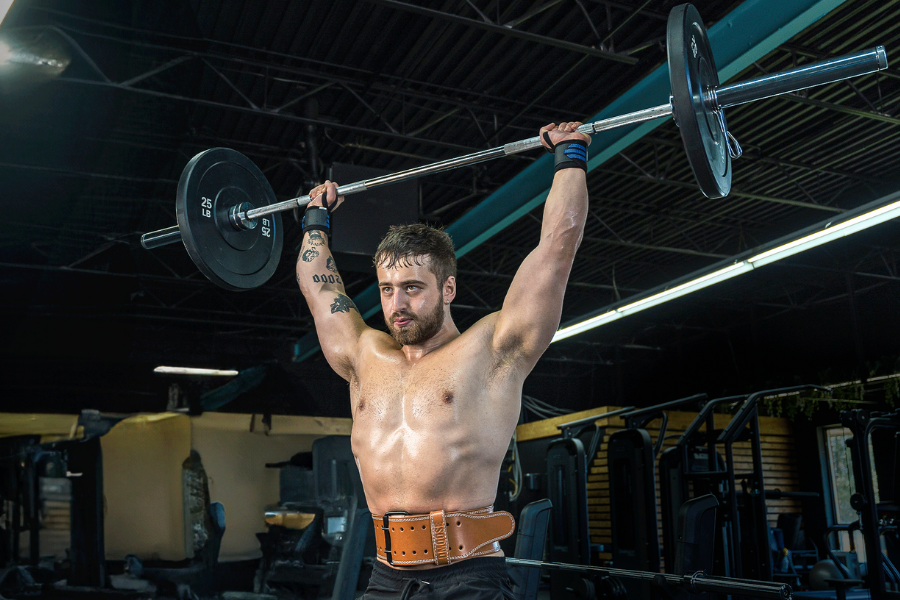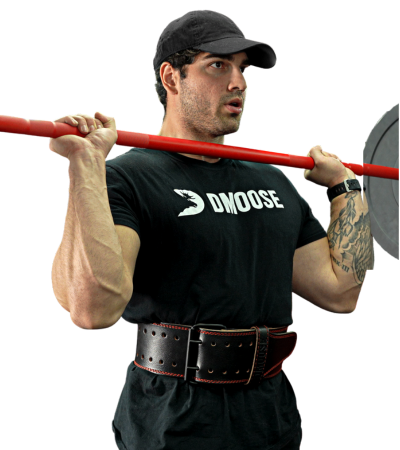Lifting heavy? A weightlifting belt can be your best friend. It’s not just about looking the part; these belts are crucial in supporting your lower back and maintaining proper posture during intense lifts. By increasing intra-abdominal pressure, a well-fitted belt creates a tight core, stabilizing your entire midsection and reducing stress on your spine.
But there's a right way to wear one, and getting it wrong can actually do more harm than good. Let’s explore the correct steps to effectively strap on your belt, ensuring you lift heavier, safer, and more efficiently.
How to Wear a Weightlifting Belt?
Lifting heavy? A weightlifting belt can be your best friend. It’s not just about looking the part; these belts are crucial in supporting your lower back and maintaining proper posture during intense lifts. Research shows that by increasing intra-abdominal pressure, a well-fitted belt creates a tight core, stabilizing your entire midsection and reducing stress on your spine.
But there's a right way to wear one, and getting it wrong can actually do more harm than good. Let’s explore the correct steps to effectively strap on your belt, ensuring you lift heavier, safer, and more efficiently.
If you're using a belt for heavy lifts like deadlifts or squats, it's crucial to wear it the right way to really benefit from it. Here’s a simple guide to wearing a lifting belt correctly.
Step 1: Position Your Weightlifting Belt Around Your Waist
First, make sure you have the right size belt that comfortably fits around your waist. It should sit just above your hips and below your ribcage, right where your lower back needs the most support during lifts.
Check the belt's position by moving around a bit to see if it pinches or feels too tight. This could mean it's not positioned right, or it might be too thick. Belts come in different thicknesses, like 10 mm or 13mm—the thicker the belt, the stiffer it is.
Step 2: Inhale and Secure the Belt
Place the belt and take a deep breath to puff up your diaphragm. Tighten the belt so it’s firm but still allows you to breathe and move. The idea is to support your spine by creating pressure in your abdomen, but you should still be able to fit your index finger behind the belt. Too tight or too loose, and it won’t work as intended.
Belts can have different closures—Velcro, prongs, or levers. Lever belts are simple; just pull the lever to tighten. Prong belts work like regular belts, and Velcro gives you a bit more flexibility to adjust.
If you’re new to prong belts, wrap it around your waist just above the hips, thread the end through the buckle, pull to tighten, and secure the prong in a hole that gives you a good fit.
Step 3: Breathe and Expand Your Core
The main job of a lifting belt is to help stabilize your back by enabling you to brace your core muscles effectively. With the belt secure, keep your core tight and breathe against the belt while lifting. This helps maintain the necessary pressure throughout the lift.
Remember, a lifting belt isn’t a magic fix. It aids your lift but doesn’t replace proper form and technique. You need to master the basics of bracing and breathing to make the most of it.
Related Article: Lever Vs. Prong Belt: How to Choose the Best One for Your Needs
Where to Wear Weightlifting Belt

When it comes to wearing a weightlifting belt, placement is key for both comfort and effectiveness. The belt should be worn around the natural waist, which is typically the narrowest part of the torso, right above the hip bones. This position varies slightly depending on the individual’s body shape and the specific exercise being performed.
For exercises like squats and deadlifts, the belt is typically positioned slightly higher on the back to provide maximum support for the lower spine. According to a study, this helps in creating a solid and safe lifting posture by increasing the intra-abdominal pressure, which stabilizes the spine during heavy lifts.
On the other hand, during overhead presses or exercises that involve a lot of upper-body movement, the belt might be worn slightly lower to allow for better mobility and comfort while still providing support to the lower back.
What Size Weightlifting Belt Should I Get

When selecting a weightlifting belt, it's crucial to choose one that fits well to ensure comfort and effectiveness during your workouts. The size of the belt should be based on your waist measurement, typically taken around the area where the belt will sit, which is usually around the navel. Most weightlifting belts come in sizes ranging from extra small to extra large, with each size covering a range of waist measurements.
Always refer to the manufacturer's sizing chart, as sizes can vary between brands. Additionally, ensure the belt fits snugly but not so tight that it restricts breathing or movement. A well-fitting belt will provide the necessary support without discomfort.
Which Belt Should I Get

If you're considering a quality belt, the DMoose 5mm Weightlifting Belt is an excellent choice. It comes in a range of sizes from small to XXL, catering to various body types and preferences.
The DMoose 5mm Weightlifting Belt is designed with durability and functionality. It features a sturdy 5mm thickness that provides a solid brace for your back, helping increase intra-abdominal pressure for better stability during heavy lifts. This belt also has a secure, easy-to-use buckle that ensures it stays in place, even during the most intense workouts.
To find the perfect fit, it's essential to measure your waist around the area where the belt will be worn, usually around the belly button. Once you have your measurements, compare them with the sizing chart on the DMoose website to find the size that best fits your dimensions. This ensures that the belt will provide the maximum benefit and support needed for safe and effective lifting.
Check out the DMoose 5mm Weightlifting Belt and its size chart: DMoose 5mm Powerlifting Belt. Make sure to measure carefully and choose the right size for your needs!
How to Break in a Weightlifting Belt?

To break in a weightlifting belt, follow these steps:
- Wear it frequently: Start wearing your belt during your workouts. The more you wear it, the more it will mold to your body shape.
- Manual bending: Bend the belt back and forth and twist it to soften the material.
- Roll it up: Roll the belt tightly and leave it rolled up overnight or when not in use. This helps to soften the leather.
- Use leather conditioner: Apply a leather conditioner to the belt to help soften it and reduce stiffness.
- Gradual adjustment: Gradually increase the tightness and duration you wear the belt during workouts to avoid discomfort and ensure it molds correctly.
By following these steps, you can effectively break in your weightlifting belt, making it more comfortable and supportive during your lifts.
Related Article: How to Break in a Lifting Belt (5 Easy and Effective Ways)
How to Measure for a Weightlifting Belt?

To ensure that a weightlifting belt fits correctly and provides the necessary support during your workouts, it's important to measure yourself properly before purchasing. Here are the steps to measure for a weightlifting belt:
- Find the Right Spot: Unlike measuring for clothing, you should measure for a weightlifting belt at your waist where you will actually wear the belt. This is usually around the belly button for most people, not where your pants sit.
- Use a Flexible Tape Measure: Use a soft, flexible tape measure to wrap around your waist. Make sure the tape is snug but not too tight. It should lay flat against your skin or a thin shirt but shouldn't compress your skin.
- Breathe Normally: While measuring, stand straight and breathe normally. Avoid sucking in your stomach or expanding it too much. This will help ensure that the belt fits comfortably and effectively when you are lifting.
- Record the Measurement: Check the number on the tape measure right after you exhale. This gives you a middle ground of your natural waist measurement, which is useful for finding a belt that can be tightened enough to support heavy lifts yet remain comfortable.
- Check Sizing Charts: Once you have your measurement, compare it to the sizing chart provided by the weightlifting belt manufacturer. Each brand might have slight variations in their sizing, so it's important to use their specific chart.
- Consider Overlap and Closure Type: Think about how much overlap you want in the belt (the amount of belt that extends beyond the buckle when fastened) and what type of closure (lever, prong, Velcro) you prefer. Some lifters like a bit more overlap for added support and security.
How Tight Should a Weightlifting Belt Be?

A weightlifting belt should be snug enough to provide substantial support while still allowing for full breaths and comfortable movement. Ideally, you should be able to fit one or two fingers between the belt and your stomach when it’s fastened.
Before lifting, tighten the belt to where it feels tight against your abdomen but not so tight that it restricts your breathing or movement. This ensures the belt can effectively stabilize your core and support your spine during heavy lifts without shifting or causing discomfort as you exercise.
The Bottom Line
Selecting and properly fitting a weightlifting belt is essential for enhancing your lifting performance and protecting your spine. By measuring correctly, ensuring the belt is snug but not restrictive, and positioning it properly, you can maximize your lifts safely and effectively.
Remember, the right belt can make a significant difference in your training regimen. For a reliable and supportive option, consider checking out the DMoose 5mm Weightlifting Belt. Visit DMoose.com for this and other high-quality fitness products to boost your workouts.
Reading List
Can Wearing a Belt for Overhead Press Increase Performance?
Traveling With Your Lifting Belt: A Guide to Stay Fit On-The-Go
Should You Wear a Weightlifting Belt While Training?
How and When to Use a Weightlifting Belt?
7 Simple Tips to Choose the Right Weightlifting Belt | Do Not Get Scammed
Article Sources
- Bourne, N. D., and T. Reilly. “Effect of a Weightlifting Belt on Spinal Shrinkage.” British Journal of Sports Medicine, vol. 25, no. 4, Dec. 1991, pp. 209–12. PubMed Central, https://www.ncbi.nlm.nih.gov/pmc/articles/PMC1479027/.
- Fong, Shirley S. M., et al. “The Influence of Weightlifting Belts and Wrist Straps on Deadlift Kinematics, Time to Complete a Deadlift and Rating of Perceived Exertion in Male Recreational Weightlifters.” Medicine, vol. 101, no. 7, Feb. 2022, p. e28918. PubMed Central, https://doi.org/10.1097/MD.0000000000028918.

















